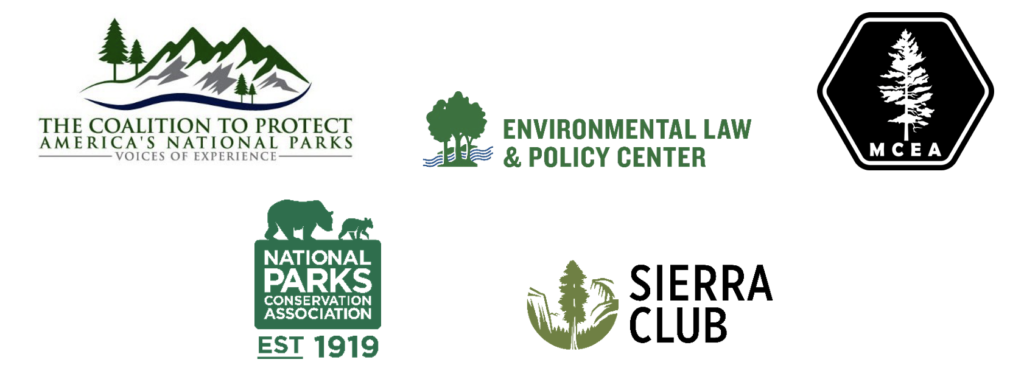
October 7, 2022
Submitted electronically via MPCA webpage
Minnesota Pollution Control Agency
c/o Maggie Wenger
520 Lafayette Road
St. Paul, Minnesota 55155
Re: Minnesota’s Draft State Implementation Plan for Regional Haze Round II
Dear Ms. Wenger:
The Coalition to Protect America’s National Parks, Environmental Law & Policy Center, Minnesota Center for Environmental Advocacy, National Parks Conservation Association, and Sierra Club submit these comments and attached report1Attached to the comments is “Review and Comments on Reasonable Progress Controls for the Minnesota Regional Haze Plan for the Second Implementation Period,” which was prepared for NPCA and Sierra Club by Victoria R. Stamper (October 5, 2022) (Enclosure 1, “Stamper Report”). Ms. Stamper is an independent air quality consultant and engineer with extensive experience in the regional haze program. regarding the Minnesota Pollution Control Agency’s (“MPCA”) Draft State Implementation Plan (“Draft SIP” or “proposed SIP”) Update for Regional Haze. Minnesota’s Draft SIP, as published on August 22, 2022, outlines the state’s plan for pollution reduction during the second Regional Haze implementation period (“Round II”).
The Coalition to Protect America’s National Parks (“Coalition”) is a non-profit organization composed of over 2,100 retired, former and current employees of the National Park Service (NPS). The Coalition studies, speaks, and acts for the preservation of America’s National Park System. As a group, we collectively represent over 40,000 years of experience managing and protecting America’s most precious and important natural, cultural, and historic resources.
Environmental Law & Policy Center (“ELPC”) is a nonprofit organization that advocates and litigates to protect air and water quality and natural places throughout the Midwest and Great Lakes region. ELPC is headquartered in Chicago, and has regional offices and members throughout the Midwest, including an office in Minnesota. ELPC has long advocated for reducing emissions of air pollution that harms public health, exacerbates climate change, imperils the natural environment, and impairs recreational and aesthetic enjoyment of natural places.
Minnesota Center for Environmental Advocacy (“MCEA”) is a nonprofit environmental organization that works in the courts, the legislature, and state agencies to protect Minnesota’s environment, natural resources, and the health of its people.
National Parks Conservation Association (“NPCA”) is a national organization whose mission is to protect and enhance America’s national parks for present and future generations. NPCA performs its work through advocacy and education, with its main office in Washington, D.C. and 24 regional and field offices. NPCA has over 1.7 million members and supporters nationwide, with more than 31,000 in Minnesota. NPCA is active nationwide in advocating for strong air quality requirements to protect our parks, including submission of petitions and comments relating to visibility issues, regional haze State Implementation Plans, climate change and mercury impacts on parks, and emissions from individual power plants and other sources of pollution affecting national parks and communities. NPCA’s members live near, work at, and recreate in all the national parks, including those directly affected by emissions from Minnesota’s sources.
Sierra Club is a national nonprofit organization with sixty-seven chapters and more than 832,000 members dedicated to exploring, enjoying, and protecting the wild places of the earth; to practicing and promoting the responsible use of the earth’s ecosystems and resources; to educating and enlisting humanity to protect and restore the quality of the natural and human environment; and to using all lawful means to carry out these objectives. Sierra Club has long participated in Regional Haze rulemaking and litigation across the country in order to advocate for public health and our country’s national parks.
As detailed below, Minnesota Pollution Control Agency’s proposed SIP will not result in reasonable progress towards improving visibility at the Class I areas its sources impact. To satisfy the Clean Air Act (“Act” or “CAA”) and Regional Haze Rule (“RHR”), MPCA must correct the flaws identified in these comments and in the attached technical report by Victoria Stamper before submittal to EPA, including:
-
-
- MPCA ignored recommendations from the Federal Land Managers (“FLMs”);
- MPCA’s Draft SIP unlawfully fails to conduct Four-Factor Analyses and include controls on the six taconite sources, which are generally among the highest Q/d values for the State’s two Class I areas, erroneously relying on an “effectively controlled” argument;
- MPCA’s Draft SIP unlawfully fails to include practically enforceable emission limitations, as required by the Clean Air Act;
- MPCA’s Draft SIP unlawfully relied on an announced retirement and failed to consider whether cost-effective control measures could be implemented in the meantime;
- MPCA’s Draft SIP unlawfully relies on unenforceable, recent emissions, which are lower than permitted emissions and failed to consider if there were additional cost-effective controls; and
- MPCA ignored cost-effective controls for the sugar beet sources.
-
Though we think there are improvements that need to be made to the SIP, we’d like to commend MPCA for proposing a technically sound regional haze plan for this planning period. MPCA had a robust source selection process, rejected international endpoint adjustments, used a good initial screening cost threshold, and committed to working with the NPS and other federal land managers throughout the consultation process.
Click here to read the full letter and attachments.
